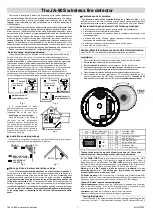
Specification of allowable distortion levels for airborne sound (test level and distortion)
Frequency (Hz)
Test level for
Supra-aural earphone
(dBHL)
Test level for Circum-aural
and Insert earphone
(dBHL)
Allowed THD
(%)
125-250
75
65
2.5
315-400
90
80
2.5
500-5000
110
100
2.5
Specification of allowable distortion levels for bone conducted sound (test level and distortion)
Frequency (Hz)
Test level for
bone vibration
(dBHL)
Allowed THD
(%)
250-400
20
5.5
500-800
50
5.5
1000-4000
60
5.5
For higher output levels than those specified in the tables above, transducers will produce higher distortion levels. The dis-
tortion is generated almost exclusively by the transducers, as the audiometer itself produces negligible distortion. Based
on the extensive knowledge which exists regarding the standard transducers, audiologists should determine if levels higher
than those specified above can be used for a particular test.
Total harmonic distortion
Air conduction (AC) < 2.5%
Bone conduction (BC) < 5%
Selectable transducers
1
AC:
TDH 39 headphones
2
, ME-70 headphones, HOLMCO headset, HDA 300 head-
phones, and Insert Earphones
BC:
Bone conductor (Mastoid)
SF:
•
Passive sound field speaker using the built-in amplifier, or
•
External amplifier using the line output.
Transducer options depend on how Aurical Aud is ordered and calibrated.
1. All headbands supplied with transducers comply with the ISO 389 series for that model of transducer unless oth-
erwise specified.
2. Headphone TDH-39 can be supplied with two different headbands, HB7 and HB8:
- For adult skulls or above normal skull size, HB8 shall be applied (HB8 is in compliance with ISO 389-1).
- For children and below normal skull size HB7 shall be applied (HB7 provides a greater force required to accommodate
smaller skull size)
Aurical Aud
25
17 Technical specifications
















































